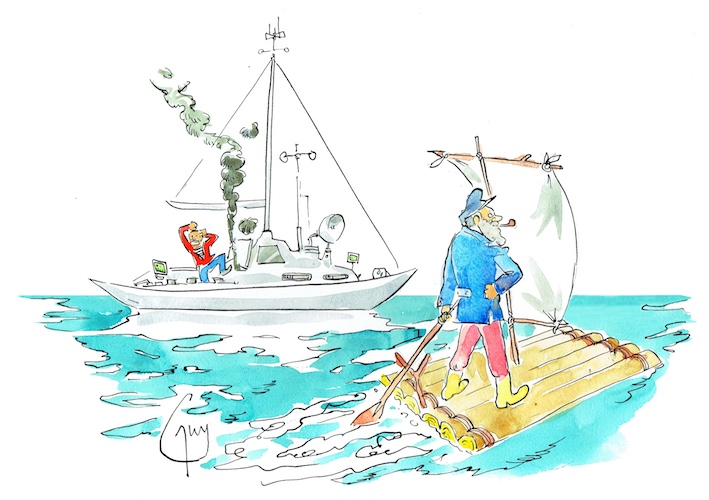Keep it simple! “One of my cruising ideals, often preached but sadly, rarely practised… How do you define simple?”
Last year I was invited to judge a cruising log competition. This is not as simple as it sounds because the forty or so cruises submitted ranged from an ambitious Arctic voyage and a cruise in Cape Horn waters to a sojourn in Scotland and a first-timer’s solo sail in the West Country. To add to the complexity there were several categories for which entries might be eligible and previous winners were excluded from some but appropriate for others.
However, any concerns I had that I would be so entangled by these complexities that my judgement might be affected were soon allayed as I was wafted from the bays of the Balearics to the anchorages of the Aleutians, from a North Sea gale to uncharted waters in Labrador. From the comfort of my computer screen I was taken on a voyage around the world and left marvelling at the achievements, great and small, of some very modest yachtsmen.
In due course I nominated the winners, the awards were presented and that was the end of that, for another year anyway. Except it wasn’t. In my summary I commented “The success and enjoyment of a cruise seems to be in inverse proportion to the complexity of the boat in which it is sailed. Too much time, it seems, is wasted head down in the bilges, waiting for engineers or spare parts whilst the simple boat sails on”.
Simplicity of boats and the way they are sailed has long been one of my cruising ideals, often preached but sadly, rarely practised. When I was equipping my Sadler 34 Dash, simplicity might have been my intention but it certainly wasn’t the result. There were more control lines than on many gaffers and my colleagues on Yachting Monthly mocked me mercilessly claiming that when I plugged into shorepower, the lights of Lymington dimmed.
Firefly, my next boat was, if anything, even more complex, complete with everything from electric winches to autopilot, radar and chart plotter to fridge and a watermaker – wonderful when it worked, less so when upended in the bilges in the Caribbean heat. Next time, I vowed, my boat will be simple, really simple.
How do you define simple? Is it a boat that is simple to operate and sail or one with minimal halyards, sheets and the like? Or is it one free of (or is it bereft of?) multiple complex electronics? Neither the Sadler nor Firefly qualified on either count. Perhaps simplicity is a boat that does not rely on complex systems of any kind to operate efficiently or one where any primary systems are quickly and easily repaired whilst at sea.
Maggie May qualifies as simple in electronic terms because all she has are a log and a depth sounder. If the latter fails then there’s always the leadline and for the sort of sailing I normally do speed and log are a bit of a luxury. But when it come to sail controls she’s up there with the best of them.
From the bow, working aft, there are the following: bobstay, jib rolling line, jib halyard, jib sheets, burgee halyard, kicking strap, peak halyard, throat halyard, mainsheet, mizzen halyard, mizzen sheet and snotter. That’s thirteen lines. Sometimes it’s a bit like playing an organ as I open and close rope clutches and heave in and ease lines. It’s good for idle hands and the end result makes it all worthwhile!
From Classic Sailor No9 Illustration: Guy Venables


